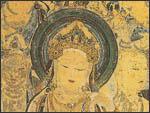
The Mogao Grottoes (Mogao Ku) also known as the Thousand Buddha Caves, constitute one of the three major Buddhist grotto sites in China. It is one of three noted grottoes in China and also the largest, best preserved and richest treasure house of Buddhist art in the world.
This honeycomb of caves was constructed over a millennium, from the 4th to the 14th centuries, and represents the height of Buddhist art and the world's richest treasure house of Buddhist sutras, murals and sculptures. It is situated 25 kilometers southeast of Dunhuang city on cliffs in the eastern Singing Sand Mountains. Dating back to the Han Dynasty, the caves contain Buddhist sculpture and frescoes from ten dynasties ending with the Tang. The art features of Mogao Grottoes, as an organic integration of architecture, sculpture and murals, systematically recorded a variety of aspects of cultural exchanges between China and the West during more than ten dynasties lasting for 1000 years from the Sixteen Kingdoms to Yuan Dynasty, which has become the rare cultural treasures and wealth of the human beings. Tang Dynasty is the heyday of Dunhuang Mogao Buddhist art. After this period, the local economy around Dunhuang declined and the production of Buddhist art lessened dramatically. In AD 366, during the Eastern Jin Dynasty, a monk named Yue Seng chiseled the first cave here. The endeavor continued through later dynasties, including the Northern Wei (386-534), Western Wei (535-556), Northern Zhou (557-581), Sui (581-618), Tang (618-907), Five Dynasties (907-960), Song (960-1279), Western Xia (1038-1227) and Yuan (1279-1368), resulting in the fantastic group of caves that can been seen today. Despite the ravages of time, the winds and sand, 492 caves are still in existence. These caves contain thousands of square meters of frescoes, created with layers of cement and clay and then painted. The caves vary in size. The smallest one just allows a head's space, while the largest one stretches from the foot to the top of the mountain, having a height of over 40 meters. The colored statues also differ in size, ranging from a few centimeters to 33 meters high, embodying the remarkable imagination of their makers. The various dynasties each feature different styles and themes, and the content of the frescoes is diversified, although themes typically revolve around Buddha images. The Mogao Buddhist sculptures were generally constructed with terracotta and then covered with a carvable plaster surface that is painted after being carved. Cave number 17 is particularly famous for its hoard of Buddhist scriptures and artwork. Despite years of erosion, the murals are still brightly colored, with clear lines. Through pictures of different styles and schools drawn in different historical periods, they tell Buddhist stories and ways as well as life in the secular world. All these, plus a largest quantity of Buddhist sutras and relics kept in the caves have provided valuable material for a study of ancient China's politics, economy, and culture and arts, as well as its science and technology, military affairs, textiles, traffic and transportation, medical science and religion, documenting national history as well as cultural exchanges between China and the world. Dunhuang Mogao Grottoes' frescos date from the 4th to the 14th centuries, containing scientific and technological inventions by ancient Chinese in the spheres of math, physics, chemistry, astronomy, geography, agronomy, architecture. In 1987, UNESCO placed the Mogao Grottoes under the protection of the world cultural heritage list. Opposite the Mogao Grottoes at the foot of Sanwei Mountain, the Dunhuang Art Exhibition Center was built by the Dunhuang Art Study Institute with donations by Japanese contributors, which made the visiting more colourful.